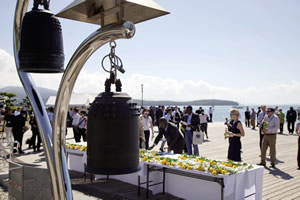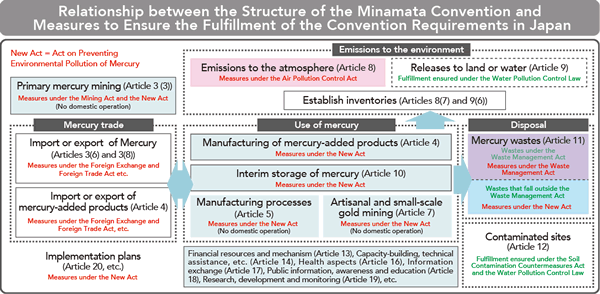Feature
Minamata Convention on Mercury and Mercury Management Efforts in Japan
Since 2001, intensive discussions have been focused on the global mercury management to reduce the risks to human health and the environment from emissions and releases of mercury and mercury compounds. In October 2013, the "Minamata Convention on Mercury" was adopted at the diplomatic conference held in Kumamoto Prefecture. In June 2015, to implement the Convention, Japan promulgated the Act on Preventing Environmental Pollution on Mercury that regulates mercury pollution throughout its lifecycle and the amendment of the Air Pollution Control Act that regulates mercury emission to the atmosphere.

Laying flowers at the Memorial Cenotaph for Minamata Disease Victims in the diplomatic conference

Heating amalgam to evaporate mercury (Province of Quezon, Philippines)
Minamata Convention on Mercury and Japan's contribution
Since 2001, the United Nations Environment Programme (UNEP) has conducted research studies and alerted the world to the state of the global mercury pollution. In 2009, responding the issue, UNEP Governing Council decided on the need for further action on mercury, including the preparation of a global legally binding instrument, and after the series of intergovernmental negotiations, the "Minamata Convention on Mercury (hereinafter Minamata Convention)" was finally adopted at the Diplomatic Conference in Kumamoto Prefecture in October 2013. We have contributed to the adoption of the Convention since the negotiating stage including hosting the second Intergovernmental Negotiation Committee (INC2).
The Minamata Convention is based on the concern owing to its persistence and long-range transport once introduced to the environment, and the adverse effects on human health and the environment that may be resulted through bioaccumulation. Recognizing the substantial lessons learned of Minamata disease, the Minamata Convention aims to reduce the risks to human health and the environment from emissions and releases of mercury and mercury compounds.
Act on Preventing Environmental Pollution on Mercury and the amendment of the Air Pollution Control Act
The Minamata Convention requires its parties to take action for the environmentally sound management of mercury throughout its entire life cycle. The legislative system in Japan regulates mercury in various ways, and the domestic measures to ensure the fulfillment of our obligations involve a number of laws. Here, I would like to give an outline of the Act on Preventing Environmental Pollution on Mercury and the amendment of the Air Pollution Control Act promulgated in June 2015.
Through the deliberations at the Central Environment Council in 2014, the Act on Preventing Environmental Pollution on Mercury and the amendment of the Air Pollution Control Act were passed at the Diet session in June 2015. The Act on Preventing Environmental Pollution on Mercury requires the government to develop an Implementation plan for the Convention and prohibits primary mercury mining, manufacturing specific mercury-added products, utilizing mercury in specific manufacturing processes and gold mining. The Act also regulates the storage of the specific mercury, specific mercury compounds and part of mercury waste. The amendment of the Air Pollution Control Act requires a notification of establishment of the facility, coal-fired power plant for instance, that emits mercury. It also stipulates the obligation of such facilities to comply with the emission standards.
Further developing necessary Cabinet Orders and Ministerial Ordinances, Japan will implement the most advanced mercury management beyond the level required by the Convention so that we will lead global mercury management. The measures include the strengthening of the regulatory standards for the specific mercury-added products of which manufacturing, importation or exportation will be banned under the Convention (e.g. batteries and lamps) by lowering the mercury content thresholds and imposing an early phase-out date.
Japan's international cooperation on mercury management
Various parties in Japan have made efforts to promote mercury-free alternatives or reduce mercury usage under the voluntary cooperation among public, private and civil sectors. As a result, Japan has become a country with excellent technologies and systems for the mercury management. We believe that such technologies will also be beneficial to other countries to improve their mercury management and eventually contribute to the early and effective implementation of the convention.
At the Diplomatic Conference in 2013, Japan launched "MOYAI initiative" to support developing countries and promote information and human exchange from Minamata. MINAS (the MOYAI Initiative for Networking, Assessment and Strengthening) will further strengthen our support to developing countries through establishing a mercury monitoring network in Asia-Pacific region and conducting surveys on development needs and capacity building in developing countries, etc.



